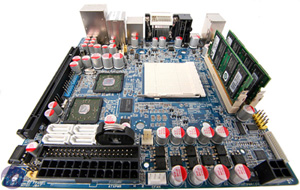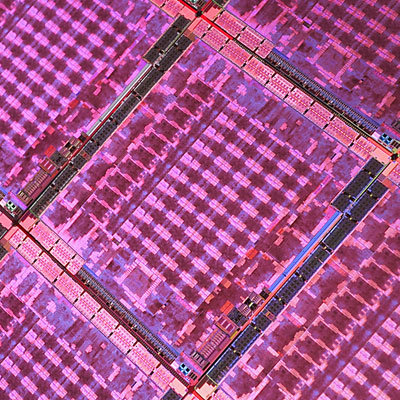
Best Innovation: ATI RV770
Notable Mentions: Intel Atom processors, J&W MINIX 780G mini-ITX HTPC mobo, Nvidia CUDA, Nvidia GeForce 9400M, Sapphire Vapour Chamber TechnologyWithout a doubt, this category is the one that caused the most arguments in the bit-tech offices. After a very heated debate, we finally came to a decision that most of us agreed on – the disagreements happened for a reason though; it’s because there have been many products (or technologies) deserving of the award this year.
Early in the year, we witnessed some brilliant innovation from AMD’s top graphics card partner Sapphire when it introduced its VaporX cooler on the Radeon HD 3870 Atomic. It used an innovative cooling technology known as Vapour Chamber Technology – the long and the short of it is that Sapphire used VCT to create the first single slot Radeon HD 3870.
Not only that, but the card was had a decent factory overclock and remained cooler than any card with the dual-slot reference cooler installed without compromising on noise. Sadly, the vastly improved cooler came at a cost and that meant the card wasn’t really worth considering as a potential purchase unless cooling was of utmost importance to you. A similarly priced Nvidia card outperformed Sapphire’s Radeon HD 3870 Atomic across the board in games, but that didn’t make the card any less innovative.
 Another one of AMD’s partners that innovated beyond the boundaries of what we thought was possible was J&W. Its MINIX 780G mini-ITX motherboard is an absolutely stunning piece of technology and we have no idea to this day how the company achieved such a feat. It has been, without a shadow of doubt, the ultimate HTPC motherboard this year.
Another one of AMD’s partners that innovated beyond the boundaries of what we thought was possible was J&W. Its MINIX 780G mini-ITX motherboard is an absolutely stunning piece of technology and we have no idea to this day how the company achieved such a feat. It has been, without a shadow of doubt, the ultimate HTPC motherboard this year.It not only redefined how we should think about home theatre PCs, but it also introduced a completely different take on packaging too. The MINIX had attention to detail unlike anything we’d seen before – unboxing the MINIX 780G was like finding a treasure chest and then feasting your eyes on what’s inside.
For all of the problems that Nvidia has had this year, it hasn’t stopped the company from innovating and driving the industry forwards. One area where Nvidia has been working hard for the past twelve months has been in GPU Computing – an area of the industry that is beginning to emerge and become increasingly more important. We think 2009 will be the year when it really takes off, but let’s not put a downer on what Nvidia has achieved with CUDA this year.
Applications have started to turn up in a big way and companies like 2K Games, Adobe, Cyberlink, Electronic Arts and Pegasys are starting to embrace GPU Computing with open arms. Nvidia acquired Ageia earlier this year and ported its PhysX API to CUDA in a matter of months and in January we are set to see the first of many PhysX-enhanced titles with Mirror's Edge.
Now, we’ve given Nvidia a lot of flak about its CUDA (and PhysX) platform, but that’s not because the technology isn’t sound. It’s because we – and the many game and application developers we’ve spoken to – want a platform that is ubiquitous across all GPUs. It’s a good thing, then, that OpenCL and DirectX 11 Compute are just around the corner. And if you’re wondering where a lot of the ideas for these two APIs came from, look no further than CUDA. Of course, AMD has its own GPU Computing SDK – Stream SDK – but it’s not been as prevalent as CUDA and there hasn’t been as much buzz from the other side of the industry.
The other real innovation we've seen from Nvidia has been the GeForce 9400M integrated graphics chipset. While it was announced a little too late in the year to make a massive impact on the industry, it's definitely one for the future. Not only has Apple adopted it for all of its MacBooks, but many other manufacturers are doing the same.
GeForce 9400M is never going to set the world on fire with blistering frame rates, but what it does do is raise the bar for integrated graphics in notebooks. What’s more, if Nvidia has its way with the Ion platform, it will raise the bar in netbooks as well – and that can only be a good thing for the industry and consumer choice. We don’t want to see game developers constrained by Intel’s integrated graphics because, frankly speaking, even Intel knows they are not for gaming. That's something the GeForce 9400M hopes to change if Nvidia grabs enough design wins.
Yet, one of the biggest buzz words of the year has been the netbook and their explosion onto the scene was partly because of the Eee PC 701’s massive success late last year, but also because Intel released the Atom processor – a new class of CPU designed to deliver ‘good enough’ computing to the masses. Now, many of you are still hugely sceptical about the need for a device that can’t be used for much more than browsing the Internet, watching a few YouTube videos, checking your email or writing a Word document – judging from the sales figures we’ve seen though, there is every reason to believe that there is a need for such a device.

RV770: It's what legends are made of.
Who knows, but what one can make of this is that the introduction of the Atom processor lit a fuse that has attracted big guns like Acer, Dell, Lenovo, Samsung and – if rumours are to be believed – Sony. Of course, only a few manufacturers could create an entirely new market almost overnight but regardless of that, what Intel has achieved with Atom in such a short space of time is incredible.
The current iteration of the platform isn’t everything we’d want to see – we want 24 hours of battery life for a start – and we remain unconvinced by the various Mobile Internet Devices we’ve seen appearing on the market, but Atom has had a massive impact on the industry in 2008. Hopefully, as process technology gets better and Intel develops more aggressive power saving technologies (a new chipset please), we’ll see x86-based smart phones before long.
Fortune favours the brave
These limitations prevented us from making Intel’s Atom processor our innovation of the year and instead that title fell to the chip behind the hugely successful Radeon HD 4800 series. RV770 is, quite frankly, the best thing that has happened to the graphics industry since Nvidia launched G80 and what made it all the more impressive was the fact it was developed while AMD was getting its ass handed to it by G80.RV770 represented an incredibly brave move for AMD because it went against what the graphics industry stood for. For years, ATI and Nvidia had cracked heads in a battle for superiority that traditionally focused on nothing but brute force – build a bigger GPU than your rival and you’re guaranteed to win. That wasn’t the case with RV770 and many got the impression that AMD was giving up on the high end.
The reason AMD won this round was because it had focused on making the most efficient GPU possible and decided not to go for broke with a GPU bigger than Vicky Pollard’s belly, as impressive as that is. Luck also came into the equation as well because AMD had decided to stick with a 256-bit memory interface to keep the size of the GPU reasonable and, in order to make up for the bandwidth deficiency, it led development of a new memory technology: GDDR5.
 Had the memory manufacturers not been able to deliver GDDR5 DRAMs in volume when they did, AMD would have been left with just the Radeon HD 4850 at launch – a card that was only really a credible threat to the GeForce 9800 GTX. Lady luck was with AMD though and it was able to deliver the Radeon HD 4870 512MB to market on launch day. The two were significantly cheaper than the competition from Nvidia and led to some huge price cuts that would go on to hurt Nvidia’s bottom line.
Had the memory manufacturers not been able to deliver GDDR5 DRAMs in volume when they did, AMD would have been left with just the Radeon HD 4850 at launch – a card that was only really a credible threat to the GeForce 9800 GTX. Lady luck was with AMD though and it was able to deliver the Radeon HD 4870 512MB to market on launch day. The two were significantly cheaper than the competition from Nvidia and led to some huge price cuts that would go on to hurt Nvidia’s bottom line.At launch, Nvidia still held the performance crown with the GeForce GTX 280, but that changed as soon as AMD introduced the Radeon HD 4870 X2 – a card that took the GTX 280 to one side and gave it a good kicking. It took Nvidia over four months to respond to the 4870 X2 and even then it was merely an early preview of the GeForce GTX 295 which is scheduled to be launched on the 8th January at CES – and by the time the card is launched, the 4870 X2 will have gone unanswered for nearly five months. And we haven't even talked about our graphics card of the year, the Radeon HD 4870 1GB.
Had AMD not released its RV770 graphics chip, we don’t know what state the graphics industry would be in today. Competition drives innovation and competition is exactly what AMD gave to Nvidia with the innovations it made in RV770 – here’s hoping that its impact on the market drives both companies to create something great over the next six to twelve months.
We hope you've enjoyed this look back at 2008. It's been a brilliant year for technology, with some big advances being made in most areas. We'll be back up to full speed next week, as CES kicks off on the 8th - we hope all of our readers, friends and partners in the industry had a brilliant Christmas and we wish you all the best for 2009!

MSI MPG Velox 100R Chassis Review
October 14 2021 | 15:04








Want to comment? Please log in.